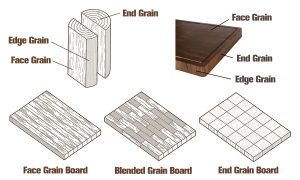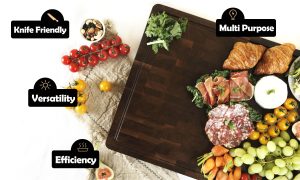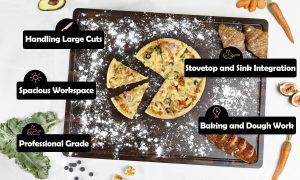
In the culinary world, precision and attention to detail are paramount, and the choice of a cutting board can significantly impact the outcome of your culinary creations. In this comprehensive exploration, we will delve into the world of cutting boards, examining the various types available, the undeniable advantages of wooden cutting boards, and an in-depth analysis of the End Grain Walnut Wood Cutting Board. By the end of this culinary journey, you’ll have a profound understanding of the craftsmanship and versatility that this remarkable cutting board offers.
1. Classification of Cutting Boards
Before we immerse ourselves in the world of End Grain Walnut Wood Cutting Boards, it’s essential to understand the diverse array of cutting board types available. Here are some common classifications.
(1) Wooden Cutting Boards: Celebrated for their natural beauty and durability, wooden cutting boards are often the preferred choice for discerning chefs. They are typically crafted from hardwoods such as oak, maple, cherry, and, of course, walnut.
(2) Plastic Cutting Boards: Known for their affordability and ease of maintenance, plastic cutting boards come in various colors to prevent cross-contamination. However, they tend to show knife marks over time.
(3) Bamboo Cutting Boards: As a sustainable option, bamboo cutting boards have gained popularity. They are durable but can be tough on knife edges due to their hardness.
(4) Composite Cutting Boards: These boards are a fusion of materials, typically wood fibers and resin. They are appreciated for their durability and resistance to staining.
2. Advantages of Wooden Cutting Boards

Wooden cutting boards offer a multitude of advantages that elevate them to a coveted status in the culinary world.
Firstly, they provide a knife-friendly surface, delicately cradling knife blades to minimize premature dulling. The innate flexibility and self-healing properties of wood fibers make it the perfect canvas for precision cutting, ensuring that your knives stay sharp.
Secondly, many hardwoods used in cutting boards possess natural antimicrobial properties, acting as a silent guardian against harmful bacteria and fungi, thereby enhancing food safety.
Beyond their functional prowess, wooden cutting boards are exquisite works of art in the kitchen, boasting unique grain patterns and rich colors that infuse warmth and elegance into any culinary setting.
Furthermore, these boards are built to withstand the test of time, with proper care ensuring their durability and resilience. They can serve you faithfully for years without warping or cracking, representing a worthwhile long-term investment in your culinary journey.
Lastly, wooden cutting boards align with environmental considerations as well. Some hardwoods, notably walnut, are celebrated for their sustainable growth, making wooden cutting boards a conscious choice for eco-minded individuals who value both performance and responsible sourcing.
3. YOUSUNLONG’s End Grain Walnut Wood Cutting Boards
Now, let’s turn our attention to the star of our culinary show—the YOUSUNLONG’s End Grain Walnut Wood Cutting Board.
(1) Material

Walnut is a high-density hardwood known for strength and durability. It’s fine, tight grain pattern ensures a smooth and even cutting surface, minimizing wear. Walnut with its low moisture content prevents cracking and warping, even with changes in humidity. This durability ensures that the cutting board will last for a long time. The natural dark brown to almost black walnut colour exudes elegance and sophistication, and its glossy surface adds timeless charm. It enhances the beauty of any kitchen. In summary, the elegance and high quality of walnut wood make it ideal for cutting boards.
(2) End Grain Structure


- Exceptional Knife Blade Protection
End grain cutting boards are renowned for their knife-friendly surface. The unique orientation of wood fibers in the end grain structure ensures that when a knife blade makes contact with the board, it encounters the open pores of the wood fibers. These open pores provide a cushioning effect, minimizing the impact on the blade. As a result, knives stay sharper for longer, reducing the need for frequent sharpening and maintenance. This protection of knife blades is particularly vital for maintaining the precision and longevity of high-quality kitchen knives.
- Durability and Resistance to Wear
End grain cutting boards are incredibly durable. The arrangement of wood fibers in the end grain pattern makes the board highly resistant to wear and tear, even with heavy chopping, slicing, and dicing. Unlike other cutting board structures that show knife marks and scarring over time, end grain boards tend to self-heal, with the wood fibers closing up after each cut. This self-healing property helps the board maintain its smooth surface and overall integrity, ensuring a long lifespan.
- Reduced Risk of Cracking and Warping
End grain cutting boards have a reduced risk of cracking and warping compared to other cutting board types. The end grain structure allows the wood to expand and contract primarily in a vertical direction, rather than across the grain. This minimizes the stress on the board and helps it remain stable, even in varying humidity levels. As a result, end grain cutting boards are less prone to developing cracks or warping, ensuring their longevity and reliability.
These advantages make end grain cutting boards a top choice for those seeking a reliable and long-lasting culinary tool that enhances the overall cooking experience.
(3) Variety of Sizes
- Efficiency in Smaller Kitchens
The 20x16x2-inch cutting board strikes a balance between size and manageability, making it ideal for kitchens with limited counter space. It offers sufficient cutting surface for various culinary tasks without overwhelming smaller cooking areas.
- Everyday Versatility
This size provides a practical and versatile cutting surface for everyday cooking needs. It’s perfect for chopping vegetables, slicing fruits, and general meal preparations. The manageable size allows for easy handling and storage.
- Knife-Friendly
Despite its smaller dimensions, the 2-inch thickness of the board offers adequate knife blade protection. It minimizes wear and tear on knife edges, ensuring your knives stay sharp for longer periods.
- Multi-Purpose
In addition to its primary role as a cutting board, this size is versatile enough to double as a cheese board or charcuterie platter when entertaining guests. It adds a touch of elegance to your presentation and serves as a convenient multi-purpose culinary tool.
- Spacious Workspace
The 24x18x2-inch cutting board provides an expansive and spacious work surface, making it suitable for extensive meal preparations. It excels when you need extra room for handling larger cuts of meat, roasts, or whole turkeys.
- Integration with Stovetops and Sinks
The size and thickness of the 24x18x2-inch board allows it to fit securely over electric or gas stoves and sinks. This integration creates additional workspace right where you need it, streamlining meal prep and minimizing countertop clutter.
- Handling Large Cuts
When dealing with substantial cuts of meat or roast, this size offers stability and ample surface area for precise carving. It ensures that you can tackle large culinary projects with ease and confidence.
- Baking and Dough Work
Bakers and dough enthusiasts will appreciate the spaciousness of this cutting board. It’s perfect for kneading dough, rolling out pastry, and shaping bread loaves, providing a stable and generous workspace.
- Professional-Grade
The 24x18x2-inch size is often favored in professional kitchens due to its durability and versatility. It can handle the demands of high-volume cooking and food preparation, making it a reliable tool for chefs.
The choice between the two sizes depends on your kitchen space and the specific culinary tasks you frequently undertake.
4. Maintenance of Wooden Cutting Boards

Proper maintenance of wooden cutting boards is crucial to ensure their longevity and performance. Here are some essential tips.
(1) Hand Washing: Always hand wash wooden cutting boards with mild soap and warm water after each use. Avoid submerging them in water for extended periods, as this can cause warping.
(2) Drying: Allow your cutting board to air dry in an upright position. Ensure it is completely dry before storing it to prevent mold growth.
(3) Oil Application: Periodically apply food-grade mineral oil, beeswax, or specific wood oils to keep the board well-nourished and maintain its natural luster.
(4) Deodorizing: If your cutting board develops odors from strong-smelling ingredients like garlic or onions, rub it with coarse salt and lemon juice, then rinse and dry.
In conclusion, the End Grain Walnut Wood Cutting Board represents the epitome of craftsmanship and excellence in the culinary world. Its unique end grain structure, knife-friendly surface, variety of sizes, and versatility make it an invaluable tool for both home chefs and professionals. With proper care, this cutting board will become a cherished companion on your culinary journey, enhancing the precision and elegance of your culinary creations.

